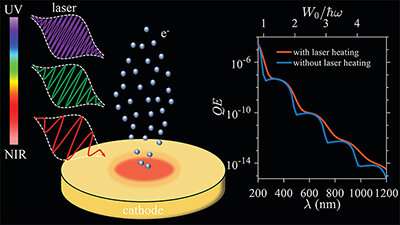Peng Zhang and Yang Zhou are working to improve the quantum efficiency of photoemission. Credit: Michigan State University
Albert Einstein might have called this research at Michigan State University a much-needed study. Einstein won a Nobel Prize in Physics in 1921 for explaining the photoelectric effect.
New research in the MSU College of Engineering may soon guide the development of better X-rays for everyday health or improving the space satellites consumers rely on every day.
Peng Zhang, associate professor of electrical and computer engineering, said that in simple terms the advancement involves ways that light dances on hard surfaces. "When light impinges on material surfaces, it can cause the ejection of electrons from the surface—a phenomenon known as the photoelectric effect. High quality electron beams for tabletop particle accelerators, intense X-rays, high-resolution electron microscopes, and high power high speed electronics need light induced electron emissions," he explained.
So Zhang and Ph.D. student Yang Zhou studied and analyzed photoemissions from metal surfaces using laser illumination. Their theoretical tests used ultraviolet wavelengths that ranged from 200 nanometers to near-infrared wavelengths of 1200 nanometers.
"Our results could help guide the development of highly efficient and bright photoelectron sources," Zhang said. "That means improvements in devices and systems including signal amplifiers in radars and satellites for space-based communications to better medical imaging for daily health."
Their research is currently featured in an article, "Quantum model considers the effect … on photoemission," in the American Institute of Physics Scilight, and "Quantum efficiency of photoemission from biased metal surfaces with laser wavelengths from UV to NIR" in the Journal of Applied Physics (2021).
More information: Chris Patrick, Quantum model considers the effect of laser wavelength, intensity, and DC bias on photoemission, Scilight (2021). DOI: 10.1063/10.0005951
Yang Zhou et al, Quantum efficiency of photoemission from biased metal surfaces with laser wavelengths from UV to NIR, Journal of Applied Physics (2021). DOI: 10.1063/5.0059497
Journal information: Journal of Applied Physics
Provided by Michigan State University























